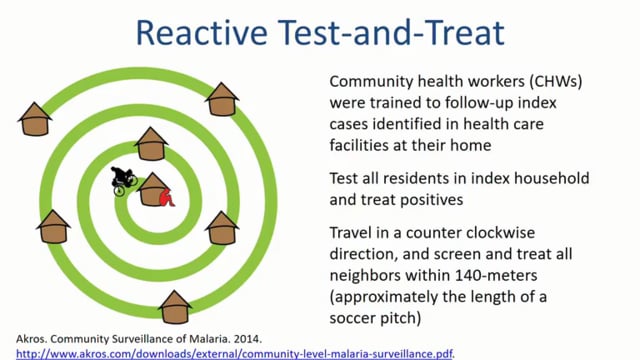Last Updated: 16/10/2014
Understanding the feasibility and potential impact of screening for asymptomatic malaria in households where a febrile case of malaria has been reported
Objectives
- To estimate the proportion of infected individuals with malaria parasites in households where a febrile malaria case occurs.
- To understand how the above estimate varies according to geography and other modifying factors.
- To understand the feasibility of interventions where members of households with a reported case of malaria (‘index household’) are screened for asymptomatic malaria and treated accordingly.
Summary of findings:
As momentum towards malaria elimination is growing new strategies are being developed for scale‐up in elimination settings. One such strategy, reactive case detection and treatment (RACD), includes screening and treating individuals living in close proximity (household members and neighbours) to passively detected cases. A study designed to evaluate the effectiveness of this strategy was carried out in Pailin province among 2,572 individuals in 440 households from May 2013 to March 2014. Participants were screened for malaria infection with rapid diagnostic tests, microscopy, and polymerase chain reaction, and given an interview to identify risk factors.
The majority of index cases (91%) were found to have P. vivax infection by RDT, were a majority male (76%), farmers (58%) or unemployed (23%), and averaged 25 years old. Nine RDT positive infections were identified through RACD (78% P. vivax, 22% P. falciparum) of which 78% were asymptomatic, while none were identified in the control group. Seventeen PCR positive infections were identified using RACD (88% P. vivax, and 12% mixed), while 25(100% P. falciparum) were in the control group (see Tables 1 & 2 in the summary of findings).
Multivariate logistic regression models were prepared to identify potential risk factors that could inform screening approaches or identify risk groups. Using fever, non‐use of nets, and history of malaria to identify individuals for RACD could have identified 40% of total PCR infections and 44% of RDT infections with only 21.7% of individuals requiring screening. Implementing these screening procedures may help increase the cost‐effectiveness of this method in Palin or similar settings. However, these results are limited by the fact that there were very few positive cases and confidence intervals were quite wide. Larger studies, or studies in higher incidence settings, may be needed to show with more precision the exact nature of the relationships described here, particularly in areas of high P. falciparum proportions.
Malaria Consortium video on the project:
Jan 2013 — Dec 2014
$140,236


